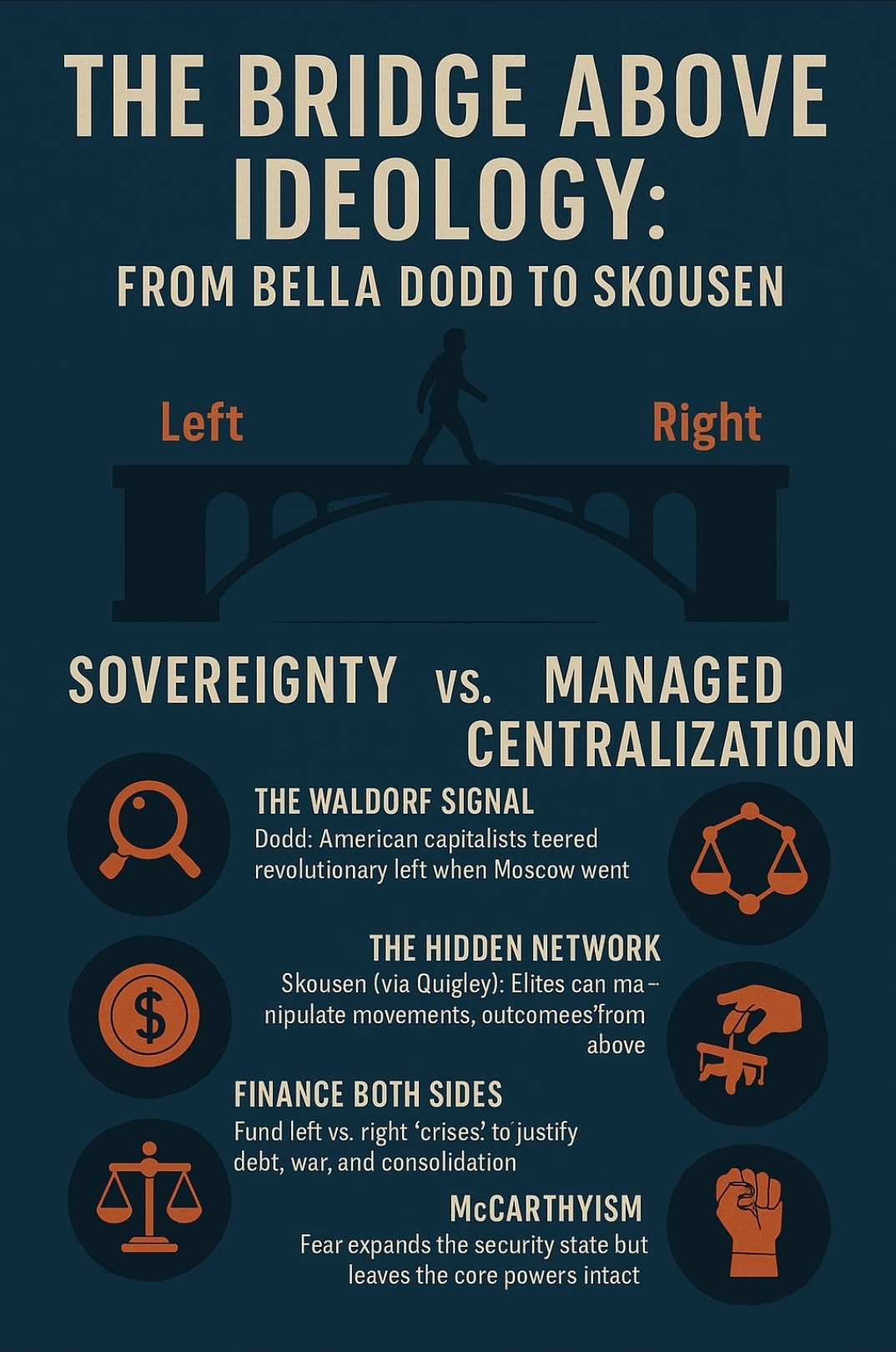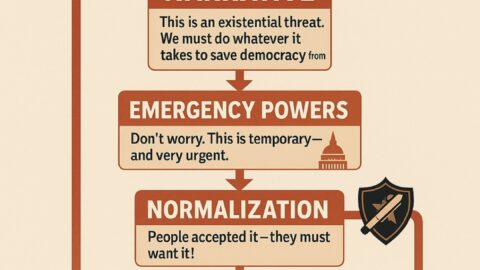To see clearly in the present, we must first recognize that what we are living through is not a collection of isolated political events, but the continuation of a long and deliberate strategy. From Dr. Bella Dodd’s warnings about a “mysterious super-leadership” directing both capitalism and communism, to W. Cleon Skousen’s The Naked Capitalist and his analysis of Carroll Quigley’s Tragedy and Hope, the pattern becomes unmistakable: global power has long used ideological conflict as camouflage. The real contest is not left versus right, but centralized control versus human freedom.
Bella Dodd’s experience inside the Communist Party revealed a shocking truth: the supposed enemies of capitalism were often funded, guided, or at least tolerated by elite financiers who profited from both systems. Quigley, writing from within the establishment, later confirmed what Dodd had intuited—namely, that a small network of global bankers and policy elites sought to manage world events through economic dependency and managed conflict. Skousen, analyzing both, called it “the war of the insiders against the rest of humanity.”
Understanding this continuity is not an exercise in nostalgia—it is the key to decoding the present. The same mechanisms Dodd described in the 1940s and 1950s—the infiltration of education, religion, and media to erode independent thought—now operate through digital platforms, financial institutions, and global NGOs. The dialectic remains identical: create or fund both sides of a conflict, control the narrative, and consolidate power through crisis.
Reading this article is therefore not just about history—it’s about reclaiming moral and intellectual sovereignty. When we trace the arc from Bella Dodd to Quigley to Skousen, we begin to see that the Cold War, the War on Terror, and today’s emerging technocratic order are chapters of the same story: a centuries-long effort to replace free, moral self-government with managed, debt-based control. To see that bridge clearly is to recognize the map of our own enslavement—and the first step toward freedom is naming the architecture of that control.
What looks like a left-versus-right cage match is, in key moments, stagecraft. Dr. Bella Dodd’s testimony that non-communist American financiers could supply “emergency instructions” to the U.S. Communist Party after WWII, and Cleon Skousen’s synthesis in The Naked Capitalist (drawing from Quigley’s Tragedy and Hope), point to a super-structure of power—a managerial-financial network that can steer both revolutionary movements and establishment institutions toward centralized control. The real conflict is not capitalism vs. communism; it is sovereignty vs. consolidation.
Part I — The Waldorf Signal: Bella Dodd’s Shock
- Observation: When Moscow went dark, the American Party was told to consult three men at the Waldorf Towers.
- Sting in the detail: None were Russians. None were communists. All were elite American capitalists.
- Implication: Ideological enemies may share a common top-down coordinator when the stakes are high—funding, timing, propaganda, and escalation/de-escalation decisions.
“I think the Communist conspiracy is merely a branch of a much bigger conspiracy.” —Dr. Bella Dodd
Part II — Skousen’s Through-Line (via Quigley)
- Quigley’s claim (admiring but candid): A transnational network of financiers cultivated access to parties, ministries, newspapers, universities, and foundations to shape long arcs of policy.
- Skousen’s inference: That network uses both left and right to achieve the same end—managed society through debt, central banking, and bureaucracy.
- Mechanism:
- Disrupt through revolution/war →
- Finance reconstruction and governance →
- Bind nations with debt, treaties, dependency →
- Normalize surveillance/administrative rule to prevent “future instability”.
Part III — The Harry Dexter White Puzzle (A Case Study)
- Known contradiction: After being identified as a Soviet agent, Harry Dexter White rose to IMF leadership with higher pay.
- Systemic reading: When an exposed node still advances, it suggests protections above politics—the agenda outweighed the embarrassment.
- Use case: Place operatives where money architecture is designed (Treasury/IMF), not merely where slogans are shouted.
Part IV — Fear Builds the Machine; Reform Lifts the Veil
- McCarthyism (1950s): Fear-driven expansion of loyalty programs and secret policing. Outcome: broader security state.
- Church Committee (1975–76): Transparent investigation of CIA/FBI/NSA abuses. Outcome: temporary oversight and disclosure.
- Continuity: The same apparatus toggles between panic (expansion) and penance (limited reforms), yet the underlying financial-administrative core remains.
Formula:
Crisis → Centralize → Consolidate → (Public backlash) → Partial Reform → New Crisis → Centralize again.
Part V — The Managerial Meta-Playbook
- Finance both sides of a conflict (insurance against outcomes; leverage in peace).
- Privatize the gains, socialize the losses (bailouts, reconstruction loans, security budgets).
- Monopolize the chokepoints (money, media, platforms, courts of last resort).
- Credential truth (universities, think tanks, “experts”), de-credential dissent (smears, deplatforming).
- Translate disruption into rule (emergency powers become norms; surveillance becomes “safety”).
Part VI — Reading Today Through This Lens
- Bipartisan sameness: Fierce rhetoric, similar outcomes—central banking primacy, expanding intel powers, permanent emergency politics.
- Culture war as cover: Moral outrage keeps the public horizontally divided while vertical consolidation proceeds.
- Digital regime: Payments, platforms, and identity systems create a turnkey architecture for programmable permission.
Part VII — Objections & Replies (Steel-manning Both Sides)
- Objection: “This is conspiracy thinking; complex systems don’t require a single cabal.”
- Reply: The claim is not omnipotent puppeteers; it’s structural concentration—interlocking boards, shared training grounds, synchronized incentives. Networks coordinate without unanimity.
- Objection: “But there are real policy differences.”
- Reply: Yes—at the layer of culture and pace. At the layer of money, surveillance, and administrative power, differences narrow.
Part VIII — Evidence Framework (How to Test the Thesis)
- Follow the money: Map donors → foundations → universities → media buys → key appointments.
- Event audits: For major crises, compile who profited, who expanded jurisdiction, who wrote the post-crisis rules.
- Document trees: Compare public narratives with memos, cables, minutes, and board records where available.
- Personnel pipelines: Chart rotations between banks, intel, defense, regulators, and NGOs.
Part IX — From Diagnosis to Defense (What We Can Do)
- Monetary clarity: Audit and constrain emergency lending; force line-item transparency in security budgets.
- Sunset everything: Emergency powers auto-expire unless re-justified with public hearings and adversarial counsel.
- Decentralize resilience: Local energy/food/payment redundancies reduce leverage of centralized gatekeepers.
- Plural media & proofs: Open archives, cryptographic document trails, and citizen FOIA cooperatives.
- Moral spine: Teach Kohlberg’s higher stages; elevate courage over tribe. Without virtue, structure won’t hold.
Conclusion — The Real Axis
Dodd’s Waldorf anecdote, Skousen’s analysis, and Quigley’s admissions converge on a simple but unsettling reframe: the decisive axis of modern politics is not left vs. right, but managed centralization vs. lived sovereignty. Spot the pattern, and the news cycle looks different; you begin to see the hand that turns the wheel, not just the spokes that spin. The task ahead is twofold: expose the architecture—and build alternatives worthy of a free people.







